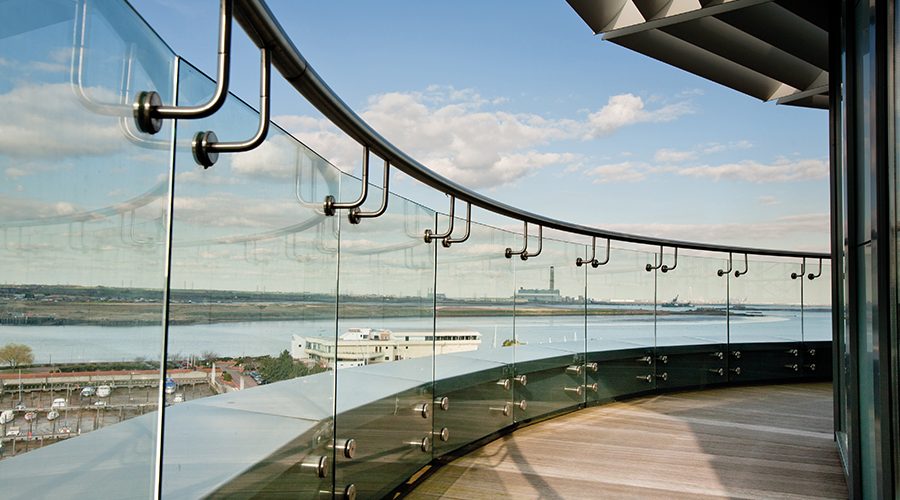Glass is one of the most practical materials used in public buildings, providing plenty of practical solutions in housing applications for the 21st century, as Scott Sinden, Managing Director of leading glass processor ESG Group, explains.
ESG
There is little doubt that the use of glass in a building envelope adds aesthetic value to building design and has some very practical benefits too. In terms of the building lifecycle, glass is one of the most hard-wearing and long-lasting materials, so it helps to ensure the long-term vision of the architect and planner. Obviously, the use of glass provides more natural light, which is why we increasingly see its use in the construction of common areas such as entry halls and stairwells.
Traditionally, multiple dwelling housing properties have had stairwells which were either exposed to the elements or enclosed, dark and gloomy. Now, with the use of toughened laminated glass, such as ESG Tufflam, we can both enclose these areas securely and flood them with natural light, adding to a sense of security and wellbeing for those living in the property.
Toughened laminated glass is manufactured by taking two panels of toughened glass, which is four to five times stronger than untreated annealed glass of the same thickness, and laminating them together with an interlayer of PVB (PolyVinyl Butyrall) or EVA (Ethylene and Vinyl Acetate copolymer.) The most commonly used is the PVB interlayer. Should either of the toughened glass panels shatter for any reason, the interlayer holds the majority of glass fragments firmly together, so that although the glass is broken, the panel will stay in place, preserving the safety barrier which safeguards residents and preventing falls. The risk of falling glass is also greatly reduced. Any fragments which do fall from a damaged panel will be small granular particles rather than potentially harmful shards of glass.
Toughened laminated glass is stronger and lighter than a thicker monolithic sheet of glass and is more structural, being able to withstand greater loads. This allows us to produce panels up to 3m in height, making floor-to-ceiling glazing in an exterior wall of a public stairwell a safe choice. The introduction of natural light also helps to reduce the energy bill for the property, with a significantly reduced need for artificial light in these common areas.
Glazed stairwells and lift shafts are increasingly popular in retail and leisure applications, but they also have real potential for residential settings, as the more transparent indoor landscape adds to personal safety and discourages anti-social behaviour.
We can also introduce fire resistance, so interior fire-resistant safety doors can be equipped with vision panels which allow residents a clear view of the far side of the door. These panels also provide a firefighter with the means to assess the situation before tackling any blaze. Toughened safety glass can be provided in compliance with either the 30-minute or 60-minute tests for fire resistance. This in-built resistance naturally also helps to buy valuable time for evacuating residents to safety.
Using a sound attenuation interlayer, we can produce glass panels which help to insulate residents from street noise and from the potential nuisance sounds from other residents. Where apartments have balconies, toughened laminated glass doors provide a practical, secure opening which can be combined with fire safety and sound attenuation.
High security can also be achieved using a technical interlayer, producing security glass which is ideal for use in the ground-floor units of multiple occupancy buildings. These may be ground-floor dwellings, but may often house retail or fast food outlets. High-security glass deters intruders, as the strength of the panel is such that repeated blows will only damage one or both glass sheets, but not breach the actual panel. By the time that an opening large enough to pass through might be achieved, the prospective intruder is likely to have been apprehended by law enforcement.
Toughened laminated glass stands up to a great deal of wear and tear; in housing applications, it can withstand being impacted by bags, shoes, footballs and even bicycles and infants’ buggies. Unlike a lot of surface-painted materials, it does not show most scuffs, so the building stays in pristine condition for longer. However, colour can be introduced by back-painting the glass panel. If block colour is not desired, housing association logos can easily be back-painted onto
a glass panel to provide a scratch-free, long-lasting community brand identity.
As glass processors, our imagination has kept pace with the creativity of the architect, so that we now have the products to help interpret even the most innovative, as well as the most practical of the architect’s concepts.
Glass, as a sustainable material, has a great role to play in public buildings in the 21st century, not least because, thanks to modern glass processing technology, it can also fulfil important functions which meet some of the demands of modern housing. We have long recognised the excellent properties of glass in construction, in terms of providing natural light and a feeling of spaciousness, but we are only now appreciating the full scope of its versatility as a building material.









